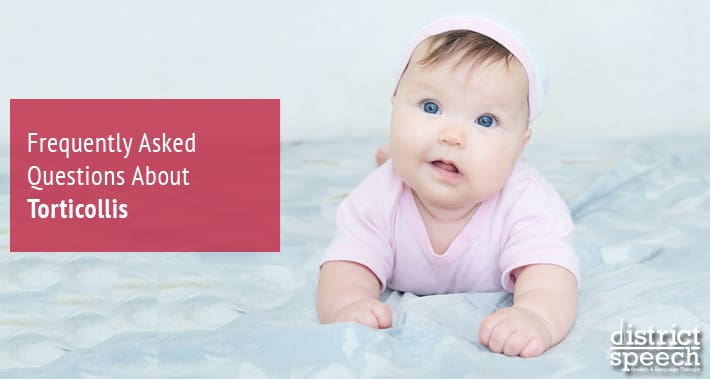
Have you noticed that your baby can’t tilt their head properly in both directions?
Or that they keep their head in a tilted position to one side?
This could be an indication that they have torticollis.
Torticollis is a medical condition that can affect both babies and adults.
However, it’s more common in infants and can affect their gross motor skills development.
As with all conditions that can affect your child’s development, early identification and intervention is key.
The sooner you have your baby evaluated by a professional pediatric physical therapist, the sooner they can receive treatment to reduce their symptoms.
Your child’s physical therapist will be able to create a custom treatment plan to help strengthen and stretch the muscles that cause torticollis.
They’ll also give you an at home exercise program to continue their treatment outside of your appointments.
At District Speech, we have both speech therapists and pediatric physical therapists in Washington DC with lots of experience treating childhood medical conditions.
Now, let’s look at some frequently asked questions about torticollis to learn more.
RELATED: Pediatric Physical Therapy For Torticollis
What Is Torticollis?
Torticollis, also known as wryneck, is a condition that often affects babies.
The term is Latin in origin and means ‘twisted neck’ in English.
It’s characterized by a shortening of the sternocleidomastoid muscle (SCM).
This is a muscle in your neck that starts at the base of your skull behind your ear and goes into your collarbone near the center of your neck.
When your baby’s SCM shortens, it causes their neck to tilt towards that side of the muscle.
It can also cause your baby’s head to rotate or turn away from the muscle, facing the opposite direction.
This is known as a three dimensional deformity of the neck which is caused by rotation and either flexion or extension, which results in a head tilt to one side.
What Causes Torticollis?
There are two main categories that potential causes of torticollis can be divided into.
It’s either the result of a bone problem, or something else.
If it’s not a bone problem causing your baby’s torticollis, it could be a neurological cause like syringomyelia or dystonia.
But, a better way to think about causes of torticollis is to consider whether it is congenital, developmental, or acquired.
Most babies have torticollis because of congenital causes, which means that they were born with it.
Most of the time, congenital torticollis is idiopathic, meaning we don’t know what causes it.
However, it can also be caused by some rare disorders, like Klippel-Feil syndrome or Sprengel’s deformity.
Torticollis in adults is typically acquired.
Some causes can include things like:
- Infection
- Ligament contractures from injury
- Drug misuse
- Trauma
Sometimes you can even get it temporarily from sleeping in an awkward position overnight.
Does Torticollis Cause Pain?
More often than not, torticollis isn’t painful.
But, that’s not always the case.
It can be painful, especially if it’s caused by a muscle spasm.
Make sure to speak with a pediatric physical therapist if you suspect your baby is in pain due to their torticollis.
Is Torticollis Dangerous?
Torticollis is not usually considered a serious issue.
Many cases respond well to treatment options like muscle stretching and physical therapy.
The exception to this is if your baby’s torticollis is caused by a serious underlying cause, like a traumatic brain injury or a neurological problem that causes muscle contractures.
How Can I Tell If My Baby Has Torticollis?
You can tell if your baby has torticollis if they can’t turn or tilt their head in both directions symmetrically.
They should be able to move their neck equally in both directions without extra help.
If you notice that your baby keeps their head in a tilted position on one side, they could have a mild form of torticollis caused by muscle contracture.
But, if you notice that your baby can only hold their head up on one side of their body, it could be a more significant form of the condition that may require surgery to resolve.
Some other symptoms to watch out for that could indicate that your baby has torticollis include:
- Plagiocephaly (flat head syndrome), a condition where your child has an unusually shaped head
- One hand or side dominating movements
- Rolling to only one side
- Lifting their head to one side only during tummy time

What Happens If Torticollis Is Left Untreated?
Leaving torticollis untreated can lead to a number of movement challenges.
Your child’s neck muscles can become tight and can impact other aspects of their development.
For example, your baby’s vision helps support nerve growth in regards to movement.
They’re more likely to move the side of their body that they are looking towards.
If they can only see one side, then they will move to one side more often, which can contribute to asymmetrical muscle, nerve, and bone growth.
This can negatively impact their gross motor skills development.
The important thing is to have your baby evaluated by a pediatric physical therapist as soon as you notice that they might have torticollis.
The faster you start their treatment, the less chance of any impact on their development as they grow.
RELATED: Important Pediatric Physical Therapy Milestones
Is Torticollis Treatable?
The good news is that torticollis is usually treatable by a pediatric physical therapist, depending on its underlying cause.
Since the majority of infant torticollis is caused by congenital muscular contracture, treatment is typically focused on stretching and massage therapy.
Your physical therapist’s goal will be to loosen your baby’s hard muscles and tendons.
This will reduce their symptoms and return their head to a normal position.
If the underlying cause is more serious, surgical intervention can sometimes be required.
For adults with torticollis, it’s typically caused by muscular or soft tissue issues, which usually responds very well to physical therapy and massage therapy.
For muscular treatment of torticollis, your baby’s physical therapist will teach you tips to help continue their progress outside of appointments.
The goal is to improve their upper body strength through tummy time, and to teach you better carrying techniques.
Each of these will help your child develop normally and reduce their chances of having torticollis.
Some other torticollis prevention tips to remember include:
- Frequently change your child’s position throughout the day
- Help them rotate their head more evenly
- Teach them some reaching movements during playtime
- Spend more tummy time with your child
RELATED: Why Is Play Important In A Child’s Development?
Book Your Appointment With District Speech Today
If you notice your child has difficulty turning their head, it’s a good idea to book your appointment with a pediatric physical therapist.
In most cases, torticollis is easily treatable.
Our team of pediatric therapists can help.
Book your appointment with District Speech today.
1300 I St NW, #400E,
Washington, DC 20005
- https://g.page/districtspeech
District Speech and Language Therapy specializes in speech therapy, physical therapy, and occupational therapy solutions, for both children and adults, in the Washington D.C and the Arlington Virginia areas.